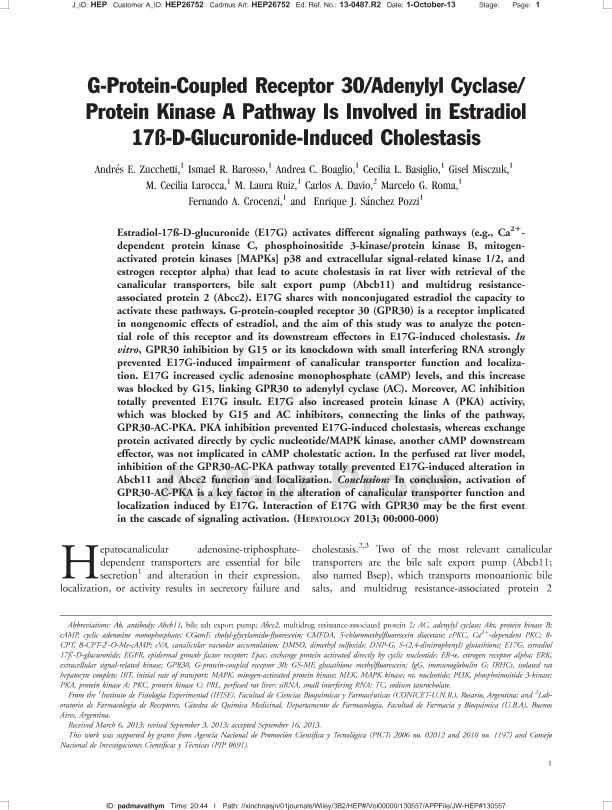Mostrar el registro sencillo del ítem
dc.contributor.author
Zucchetti, Andrés Ernesto

dc.contributor.author
Barosso, Ismael Ricardo

dc.contributor.author
Boaglio, Andrea Carolina

dc.contributor.author
Basiglio, Cecilia Lorena

dc.contributor.author
Miszczuk, Gisel Sabrina
dc.contributor.author
Larocca, Maria Cecilia

dc.contributor.author
Ruiz, Maria Laura

dc.contributor.author
Davio, Carlos Alberto

dc.contributor.author
Roma, Marcelo Gabriel

dc.contributor.author
Crocenzi, Fernando Ariel

dc.contributor.author
Sanchez Pozzi, Enrique Juan

dc.date.available
2016-06-09T14:02:23Z
dc.date.issued
2013-10
dc.identifier.citation
Zucchetti, Andrés Ernesto; Barosso, Ismael Ricardo; Boaglio, Andrea Carolina; Basiglio, Cecilia Lorena; Miszczuk, Gisel Sabrina; et al.; G protein-coupled receptor30-adenylyl cyclase-protein kinase A pathway is involved in estradiol 17ß-d-glucuronide-induced cholestasis; Wiley; Hepatology (baltimore, Md.); 59; 3; 10-2013; 1016-1029
dc.identifier.issn
0270-9139
dc.identifier.uri
http://hdl.handle.net/11336/6119
dc.description.abstract
Estradiol-17ß-d-glucuronide (E17G) activates different signaling pathways (such as cPKC, PI3K-Akt, MAP kinases p38 and ERK1/2 and estrogen receptor α) that lead to acute cholestasis in rat liver with retrieval of the canalicular transporters bile salt export pump (Abcb11) and multidrug resistance-associated protein 2 (Abcc2). E17G shares with non-conjugated estradiol the capacity to activate these pathways. The G protein-coupled receptor 30 (GPR30) is a receptor implicated in non-genomic effects of estradiol and the aim of this study was to analyze the potential role of this receptor and its down-stream effectors in E17G-induced cholestasis. In vitro, GPR30 inhibition by G15 or its knock down with siRNA strongly prevented E17G-induced impairment of canalicular transporters function and localization. E17G increased cAMP levels and this increase was blocked by G15, linking GPR30 to adenylyl cyclase (AC). Moreover, AC inhibition totally prevented E17G insult. E17G also increased PKA activity, which was blocked by G15 and AC inhibitors, connecting the links of the pathway GPR30-AC-PKA. PKA inhibition prevented E17G-induced cholestasis, whereas Epac/MEK, another cAMP downstream effector, was not implicated in cAMP cholestatic action. In the perfused rat liver model, inhibition of GPR30-AC-PKA pathway totally prevented E17G-induced alteration in Abcb11 and Abcc2 function and localization. In conclusion, activation of GPR30-AC-PKA is a key factor in the alteration of canalicular transporters function and localization induced by E17G. The interaction of E17G with GPR30 may be the first event in the cascade of signaling activation
dc.format
application/pdf
dc.language.iso
eng
dc.publisher
Wiley

dc.rights
info:eu-repo/semantics/openAccess
dc.rights.uri
https://creativecommons.org/licenses/by-nc-sa/2.5/ar/
dc.subject
Ac
dc.subject
Abcb11
dc.subject
Abcc2
dc.subject
Gpr30
dc.subject
Pka
dc.subject
Camp
dc.subject.classification
Fisiología

dc.subject.classification
Medicina Básica

dc.subject.classification
CIENCIAS MÉDICAS Y DE LA SALUD

dc.title
G protein-coupled receptor30-adenylyl cyclase-protein kinase A pathway is involved in estradiol 17ß-d-glucuronide-induced cholestasis
dc.type
info:eu-repo/semantics/article
dc.type
info:ar-repo/semantics/artículo
dc.type
info:eu-repo/semantics/publishedVersion
dc.date.updated
2016-06-08T17:55:34Z
dc.journal.volume
59
dc.journal.number
3
dc.journal.pagination
1016-1029
dc.journal.pais
Estados Unidos

dc.journal.ciudad
Nueva York
dc.description.fil
Fil: Zucchetti, Andrés Ernesto. Consejo Nacional de Investigaciones Científicas y Técnicas. Centro Científico Tecnológico Rosario. Instituto de Fisiología Experimental (i); Argentina
dc.description.fil
Fil: Barosso, Ismael Ricardo. Consejo Nacional de Investigaciones Científicas y Técnicas. Centro Científico Tecnológico Rosario. Instituto de Fisiología Experimental (i); Argentina
dc.description.fil
Fil: Boaglio, Andrea Carolina. Consejo Nacional de Investigaciones Científicas y Técnicas. Centro Científico Tecnológico Rosario. Instituto de Fisiología Experimental (i); Argentina
dc.description.fil
Fil: Basiglio, Cecilia Lorena. Consejo Nacional de Investigaciones Científicas y Técnicas. Centro Científico Tecnológico Rosario. Instituto de Fisiología Experimental (i); Argentina
dc.description.fil
Fil: Miszczuk, Gisel Sabrina. Consejo Nacional de Investigaciones Científicas y Técnicas. Centro Científico Tecnológico Rosario. Instituto de Fisiología Experimental (i); Argentina
dc.description.fil
Fil: Larocca, Maria Cecilia. Consejo Nacional de Investigaciones Científicas y Técnicas. Centro Científico Tecnológico Rosario. Instituto de Fisiología Experimental (i); Argentina
dc.description.fil
Fil: Ruiz, Maria Laura. Consejo Nacional de Investigaciones Científicas y Técnicas. Centro Científico Tecnológico Rosario. Instituto de Fisiología Experimental (i); Argentina
dc.description.fil
Fil: Davio, Carlos Alberto. Universidad de Buenos Aires. Facultad de Farmacia y Bioquímica. Departamento de Farmacología. Cátedra de Química Medicinal; Argentina
dc.description.fil
Fil: Roma, Marcelo Gabriel. Consejo Nacional de Investigaciones Científicas y Técnicas. Centro Científico Tecnológico Rosario. Instituto de Fisiología Experimental (i); Argentina
dc.description.fil
Fil: Crocenzi, Fernando Ariel. Consejo Nacional de Investigaciones Científicas y Técnicas. Centro Científico Tecnológico Rosario. Instituto de Fisiología Experimental (i); Argentina
dc.description.fil
Fil: Sanchez Pozzi, Enrique Juan. Consejo Nacional de Investigaciones Científicas y Técnicas. Centro Científico Tecnológico Rosario. Instituto de Fisiología Experimental (i); Argentina
dc.journal.title
Hepatology (baltimore, Md.)

dc.relation.alternativeid
info:eu-repo/semantics/altIdentifier/url/http://onlinelibrary.wiley.com/wol1/doi/10.1002/hep.26752/abstract
dc.relation.alternativeid
info:eu-repo/semantics/altIdentifier/doi/http://dx.doi.org/10.1002/hep.26752
dc.relation.alternativeid
info:eu-repo/semantics/altIdentifier/doi/10.1002/hep.26752
Archivos asociados
